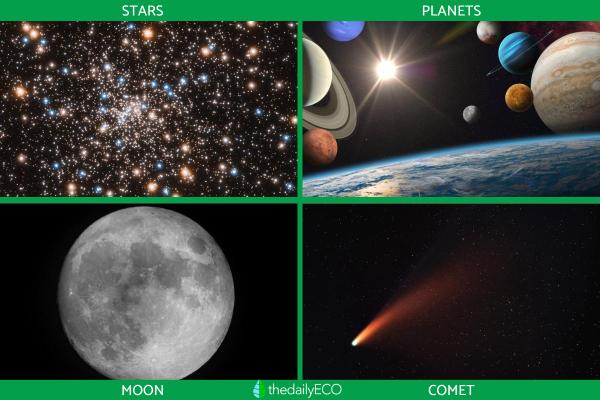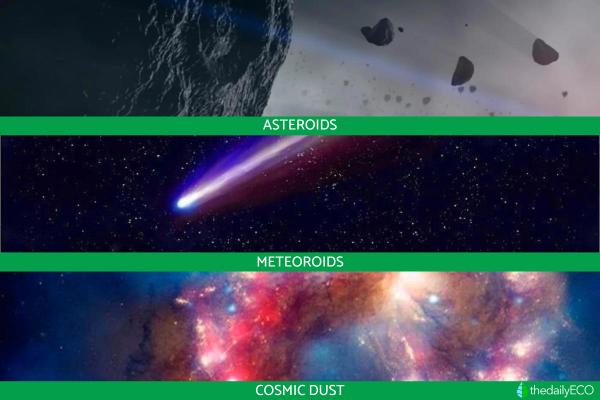
While our planet is of endless fascination to us and we are yet to discover so much of how it functions, it is only one tiny part of an infinite universe. Thanks to an endless supply of curiosity and various technological advancements, we are also able to find out more about the universe beyond Earth's atmosphere. It is sometimes too easy to think of our planet as Earth versus the rest of the universe, but really we are a part of it. We are subject to similar forces and circumstances of the rest of our vast universe, in which are contained many celestial bodies.
At thedailyECO, we help to understand our place in the universe by asking what is a celestial body? We provide a definition of celestial bodies, as well as explain the different types and present examples of some of the most common.
What is a celestial body?
In Latin, caelestis means ‘belonging to the sky’. In their most basic definition, celestial bodies are single contiguous entities which make up outer space. The definition of a celestial body is one which is relative to the planet Earth. By definition, a celestial body is one which is outside of the Earth's atmosphere (the ‘sky’ here meaning above the atmosphere).
If we were to look at space from another celestial body, then Earth would be a celestial body from that viewpoint. So we may wonder whether Earth is a celestial body, but it is dependent on in which part of the universe you are. Celestial bodies can also exist outside of our own galaxy, despite our inability to see them. For this reason, there are many celestial bodies about which we are completely unaware.
Some of the characteristics of celestial bodies are:
- Celestial bodies are individual: that is to say that they are a single object. There is another similar term called astronomical bodies, but this refers to the union of several individual celestial bodies.
- They are capable of interacting with other bodies: they do this through the law of gravity, although they can also remain individual, which is known as a wandering celestial body.
- Some emit light while others do not: celestial bodies which do not emit light are opaque.
How many celestial bodies are there?
The size of the universe is so large that humans have not been able to calculate it exactly. Even the shape of the universe is unknown. Some approximations place it with a size of 93,000 million light years, but this is only using the knowledge we have currently available.
Space contains a proportional quantity of celestial bodies, meaning it is an immense amount. Just as we can't have a sure number for the size of the universe, we can't know for sure how many celestial bodies there are. To give you an idea, it is estimated that there are 70 quintillion planets in the universe, i.e. a 7 followed by 20 zeros. This is only one type of celestial body, so you will imagine that adding up all the celestial bodies that exist, the number is gigantic.
Since it is difficult to come up with a number, below we will talk about the types and examples of celestial bodies that exist.
Types of celestial bodies
Now we have a definition of a celestial body and are aware of their basic characteristics, it is helpful to know some examples. This way we can have a better picture of what they mean. Examples of celestial bodies include:
Stars
We should be relatively familiar with stars, since they some of the most common celestial bodies we can see with the naked eye. The reason they are so visible in space is because of their gaseous composition, mainly based on hydrogen and helium. When these combust, they release energy which we perceive as light. The matter of stars is concentrated in its center where temperature and pressure come together in a compact way.
There are different types of stars that can be seen as different colors. This is due to their size, age, components, and temperature, depending on what they gather in the core. The sun is the celestial body around which our planet revolves. The sun is also a type of star and you can learn more about its composition with our article on why the sun looks yellow.
The surface temperature of the sun is 5,505°C (9941 ºF). Although this may seem like a lot to us, the stars with the highest temperatures reach over 30,000°C (54,032 ºF). The largest celestial body is the star UY Scuti, which is 5 billion times larger than our sun.
Planets
Planets do not have their own light, but they do depend on the light emitted by other celestial bodies. These are kept revolving around a star. This is our case with the sun.
Satellites
Satellites do not have their own light either. Unlike planets, they are the celestial body that revolves around a planet. An example of this is our moon, whose phases can be seen according to its position with respect to the sun and the earth. These have an effect on the gravitational force, as we can see in the tide regulated by said satellite. Other planets may have more natural satellites like Jupiter, which has no less than 80 moons.
There are also artificial satellites launched into space by man, used to collect and transmit information.
Comets
Comets are a core of ice and rock with a hazy atmosphere made up of different elements. These celestial bodies revolve around the sun in ellipses from time to time. Its characteristic tail forms when it approaches the sun and reacts with the solar winds.
Learn more about the effects of solar winds with our guide to the magnetosphere.
Asteroids
Asteroids are similar to comets, but differ in that they lack a hazy atmosphere. They are rocky celestial bodies and most of them are found the so-called asteroid belt, an area of our solar system orbiting between Jupiter and Mars.
Meteoroids
They are also rocks, but they are smaller than asteroids. They are considered small pieces of rock. They are so small that they disintegrate when they hit our atmosphere. When they do, they leave behind a trail of bright light, commonly called shooting stars.
Cosmic dust
You may be wondering what is the smallest celestial body? Following the size range of the rocks of comets, asteroids and meteoroids, this is the smallest size within the classification of celestial bodies. A piece of cosmic dust measures less than 10 microns. This dust can be found throughout the universe and often forms colored clouds, which we can see in wonderful photographs of the universe.


If you want to read similar articles to What is a Celestial Body? - Definition, Types and Examples, we recommend you visit our Facts about Earth and the universe category.
- Gunn, A. (n.d.). What is the largest known celestial body?. BBC Science Focus. Retrieved from: https://www.sciencefocus.com/space/what-is-the-largest-known-celestial-body/